Do you know about the "Q+" in LGBTQ+? ~ Latest Survey Report

Yoshimoto Taeko
※Notice of Survey Result Correction (February 20, 2024)
An error was found in the survey results cited below within the article. We apologize and have made the correction.
【Relevant Survey】
Legend and 2020 response percentages for the question: "Do you know that LGBT is one of the collective terms for sexual minorities?"
[Incorrect]
"Know" 43.3%, "Somewhat know" 36.6%, "Heard of it but don't know much" 12.0%, "Don't know" 7.9%
[Correct]
"Agree" 35.0%, "Somewhat agree" 34.7%, "Somewhat disagree" 16.3%, "Disagree" 13.9%
On March 17 this year, the Sapporo District Court ruled that the current system denying marriage to same-sex couples violates Article 14 of the Constitution, which guarantees equality under the law. This historic ruling marks the first time a court has declared unconstitutionality in a lawsuit concerning same-sex marriage.
Furthermore, protests against inappropriate remarks targeting LGBTQ+ individuals are becoming increasingly common, signaling growing societal interest in greater equality.
Dentsu Inc. Diversity Lab, which researches the field of Diversity & Inclusion (an approach aiming to respect each person's diverse individuality and promote social participation for all), launched its large-scale "LGBT Survey" in 2012, focusing on sexual minorities, including LGBT individuals.
Recognizing the growing awareness of LGBT issues, the survey renamed as the "LGBTQ+ Survey" in its April 2023 release. It provided detailed analysis not only on Lesbians (L), Gays (G), Bisexuals (B), and Transgender individuals (T), but also on the breakdown of diverse sexualities (Q+).
Note: (Q) stands for Questioning, referring to those whose gender identity or sexual orientation is not yet defined or is intentionally left undefined. (+) indicates the existence of various other sexualities.
This series introduces survey results alongside the latest societal trends and case studies. The first installment focuses on diverse sexualities beyond LGBT, covering the proportion of individuals within the LGBTQ+ community, the latest public opinion, and coming out situations.
Point ①: The LGBTQ+ demographic accounts for 8.9%. Diverse sexualities beyond LGBT constitute nearly half of this group.
This survey classifies sexuality based on three combinations: "sex assigned at birth" (birth sex), "gender identity" (how one identifies), and "sexual orientation" (the gender of the person one is attracted to). It defines the LGBTQ+ group as anyone outside the straight group (heterosexual individuals whose birth sex and gender identity match). Results from the survey conducted at the end of 2020 showed that the percentage of people identifying as LGBTQ+ remained unchanged from the 2018 survey at 8.9%.
While there was a slight increase of 1.3% from 2015 (7.6%), when awareness of the term "LGBT" itself was low, to 2018, this is thought to be due to increased information about LGBTQ+ issues and individuals confronting their own sexuality. With information now more widespread, the figure appears to have stabilized at 8.9%.
This time, we also analyzed the main breakdown of diverse sexualities based on the combinations of "birth sex × gender identity" and "gender identity × sexual orientation."
For "birth gender × gender identity," besides transgender (0.64%), X-gender (feeling neither male nor female, or both) accounted for 1.20%. Gender identity questioning (uncertain or undecided about gender identity) was 0.62%.
For "gender identity × sexual orientation," besides gay (1.94%) and lesbian (1.33%), bisexual/pansexual (attraction to men or women varies, not fixed; attracted to both men and women; gender of partner is irrelevant) accounted for 2.94%. Asexual/Aromantic (not experiencing romantic attraction toward others) was 0.81%, and questioning sexual orientation (unable to determine or unsure of sexual orientation) was 1.63%, revealing diverse expressions of sexuality.
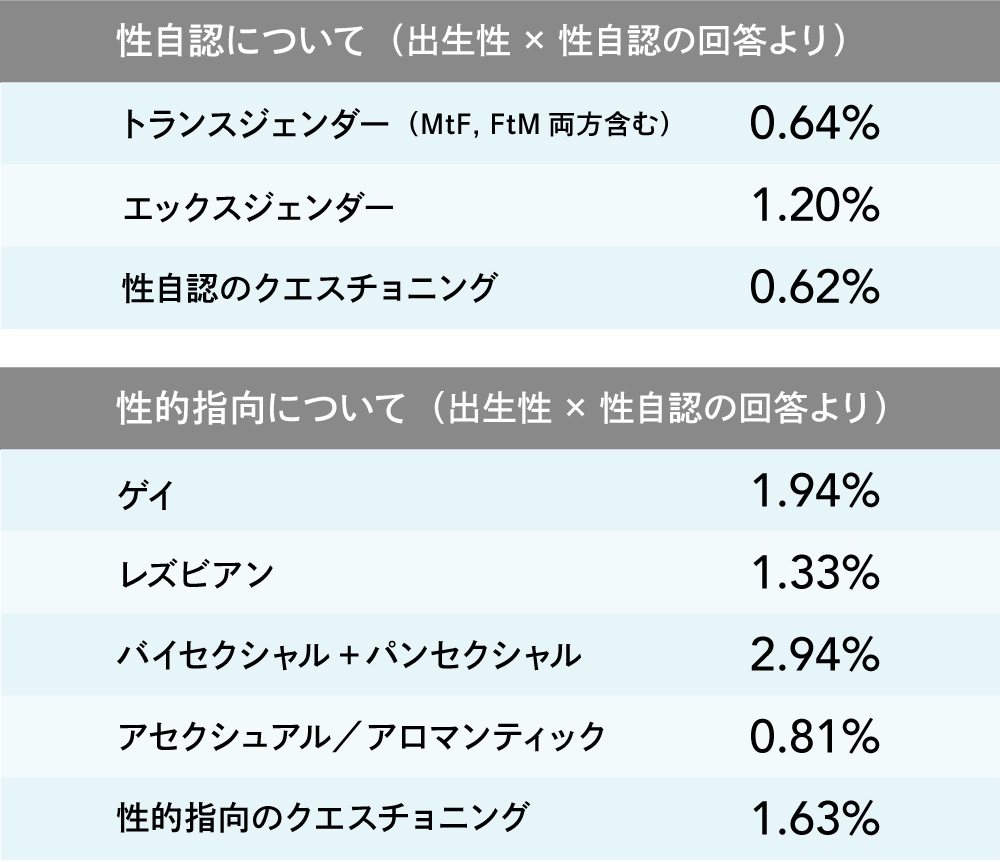
Point ②: Awareness of the term "LGBT" is approximately 70%. However, awareness of the diversity encompassed by "Q+" remains insufficient.
Next, regarding awareness of the term LGBT. It rose significantly from 37.6% in the 2015 survey to 68.5% in the 2018 survey. The 2020 survey shows a nearly unchanged result at 69.8%.
Coverage in news and documentaries has increased, significantly aided by films and books—many of which were Japanese productions, not just foreign ones. Examples include the film "Midnight Swan," featuring a transgender protagonist, winning two Japan Academy Prizes, and the book "The 52-Hertz Whales," which won the Bookstore Award, where LGBTQ+ themes were central. Content addressing LGBTQ+ individuals is growing, and further penetration in Japan is anticipated.
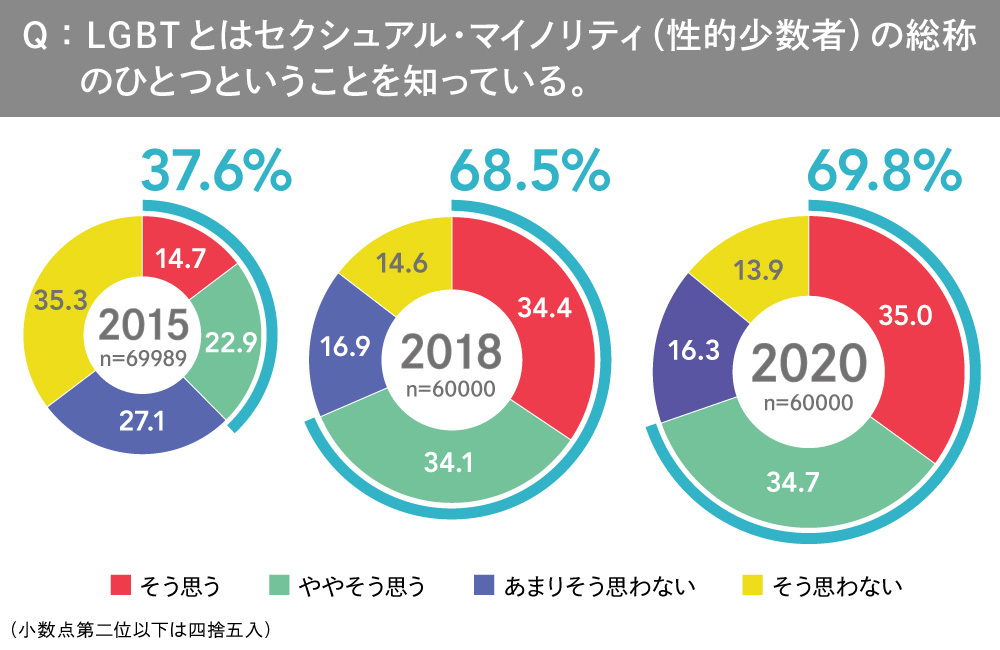
On the other hand, regarding diverse sexualities beyond L (Lesbian), G (Gay), B (Bisexual), and T (Transgender), about 80% of respondents stated they had never even heard the terms themselves. Awareness of the nearly half-represented Q+ spectrum remains significantly underdeveloped.
When considering diverse sexualities, it's important not to think solely within the L/G/B/T framework. People with gender identities that don't align with either female or male (e.g., X-gender), or those who experience no sexual or romantic attraction (e.g., asexual/aromantic), each face different challenges in their lives. Therefore, accurate understanding and consideration are essential first.
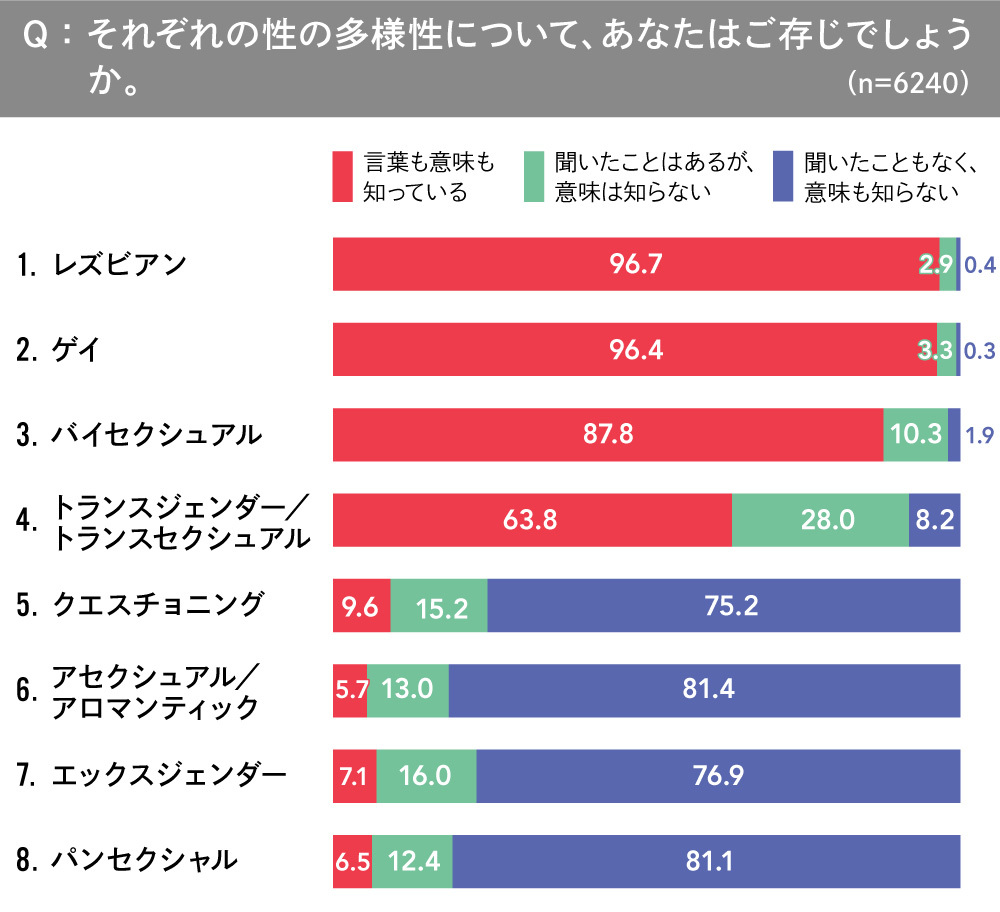
Point ③: Approximately 89% of respondents believe "sexual diversity" should be taught in school education
Major changes are also emerging in school education. The increasing adoption of "genderless uniforms" – attire that can be worn by anyone regardless of gender, breaking free from the fixed notion that girls must wear skirts and boys must wear pants – is gaining attention. According to major student uniform manufacturer "Tombow," the number of junior high and high schools nationwide adopting slacks for female students has reached approximately 1,000 schools, roughly 2.7 times the number three years ago.
When asked whether schools should teach about "sexual diversity," including LGBTQ+, the results showed a clear majority: 88.7% responded that it "should be taught" or "should be taught if possible." However, only 10.4% reported having actually received such education, revealing a significant gap. That said, in April 2015, the Ministry of Education, Culture, Sports, Science and Technology issued a notice to elementary, junior high, and high schools nationwide urging consideration for children from sexual minority backgrounds. Consequently, more schools appear to be incorporating this into their curricula.

Point ④: Slight decrease in those who haven't come out to anyone. Coming out to mothers and friends is progressing
Next, when asked whether they had come out as LGBTQ+, 57.4% responded that they had "not come out to anyone." Compared to the 2018 survey, the number of people who "haven't come out to anyone" decreased by 8.3 percentage points, suggesting a slight increase in coming out. Looking at who they have come out to, the percentage coming out to their mother increased from 9.0% to 12.9%. Additionally, the percentages coming out to male friends, female friends, and LGBTQ+ friends each increased, indicating progress in coming out to mothers and friends.
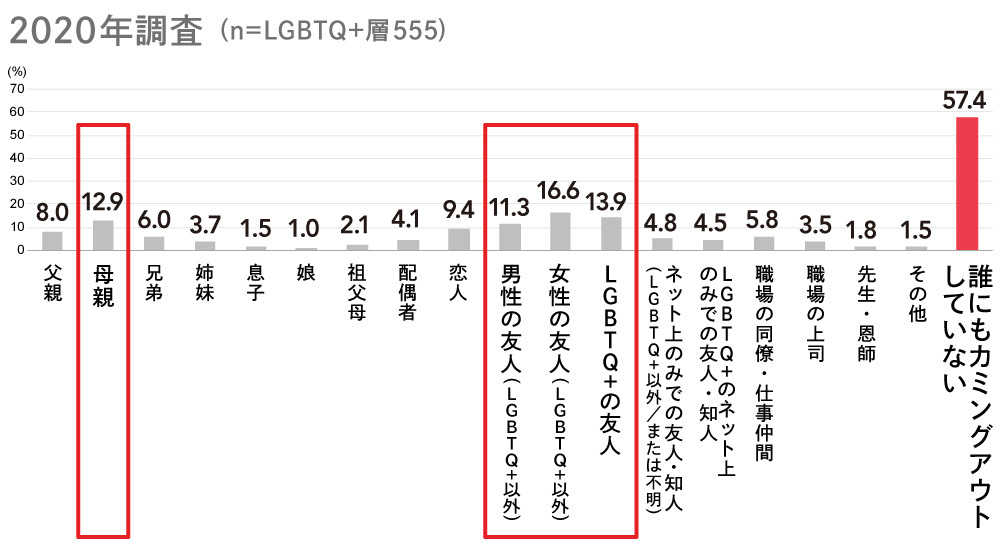
However, when asked, "Do you feel the environment has become easier for you to come out to people around you in recent years compared to before?", 70.2% of respondents answered "No," showing little change from the previous survey. It seems the environment has not improved.
However, when the same question was asked only to those living in municipalities with partnership systems (where local governments recognize the partnership of two people as equivalent to marriage), only 47.7% answered that the environment had not become easier for coming out. A majority of people answered that the environment had become easier for coming out. The partnership system, now expanding to over 100 municipalities, is likely contributing to the creation of an environment more conducive to coming out.
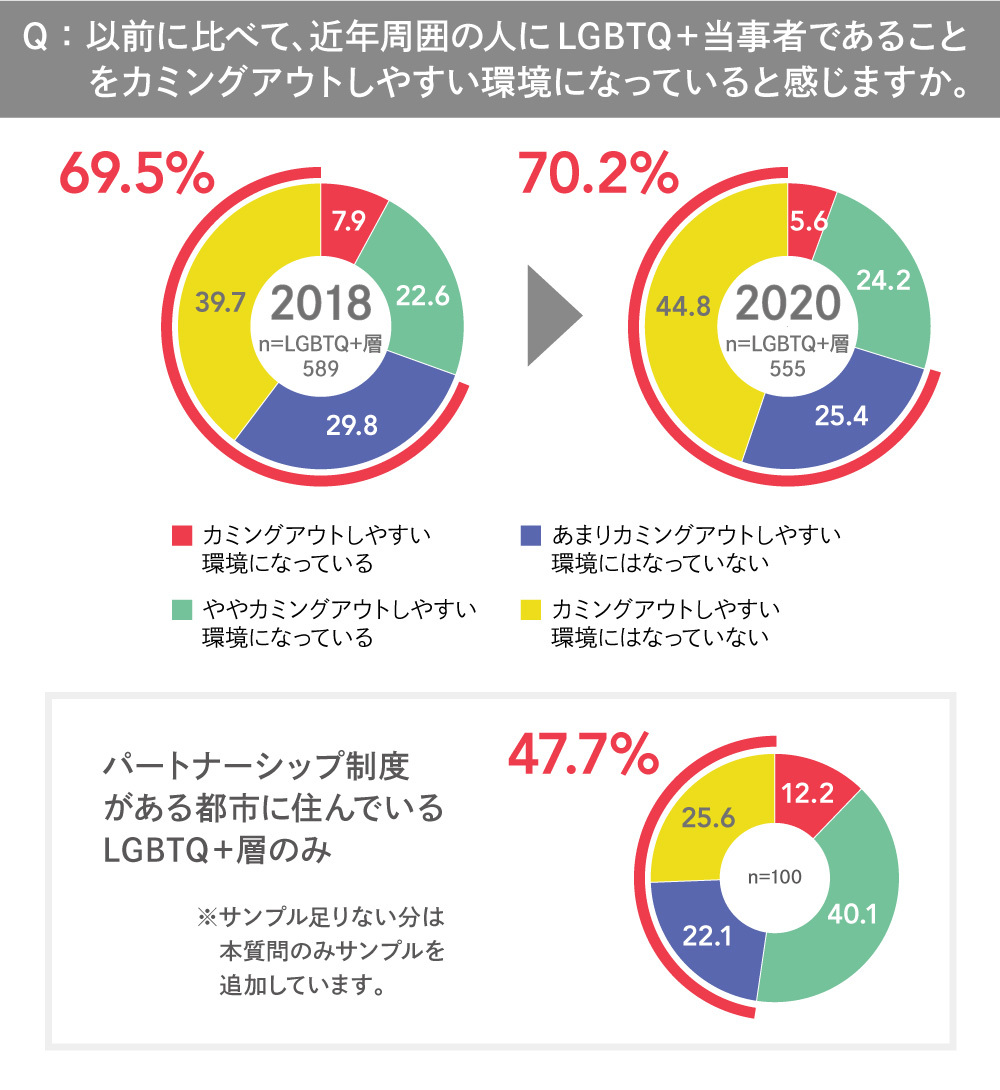
Point ⑤: Approximately 18% of those who came out to their parents reported, "I am still not accepted by my parents; I am completely rejected."
Furthermore, when asked, "How did you feel when you realized you were LGBTQ+? When asked, "How did your parents react when you came out?", 18.4% responded that they themselves still haven't been accepted. Furthermore, among those who came out to their parents, the harsh reality emerged that approximately 20% still feel "not accepted" or "completely rejected" by their father (18.7%) and mother (19.2%).

It has been about nine years since Dentsu Inc. Diversity Lab began its survey in 2012. While awareness of LGBT issues has spread and discussions on legalizing same-sex marriage have progressed, promoting recognition and accurate understanding of diverse sexualities (Q+) and creating environments where individuals can come out safely remain important challenges to address.
<Preliminary Screening Survey Overview>
・ Survey Participants: 60,000 individuals aged 20–59
・ Survey Area: Nationwide
・ Survey Period: December 17–18, 2020
・ Survey Method: Internet survey
<Dentsu Inc. LGBTQ+ Survey 2020 Overview>
・ Survey Participants: 6,240 individuals aged 20–59 (555 LGBTQ+ individuals / 5,685 straight individuals)
・ Survey Area: Nationwide
・ Survey Period: December 17–18, 2020
・ Survey Method: Online survey
* Weighting was applied by prefecture, gender, and age group (20s-30s / 40s-50s) to reflect the proportion of LGBTQ+ individuals and the overall population distribution.

Was this article helpful?
Newsletter registration is here
We select and publish important news every day
For inquiries about this article
Author

Yoshimoto Taeko
After working for approximately 8.5 years at a major domestic PR firm, I joined a U.S.-based PR firm in New York, where I primarily handled PR activities for clients in the food and beverage and hospitality sectors. Upon joining Dentsu Inc., I was mainly responsible for PR planning targeting overseas markets. Concurrently, as a researcher for Dentsu Diversity Lab, I led the LGBT Survey 2018. I left Dentsu Inc. in March 2022.